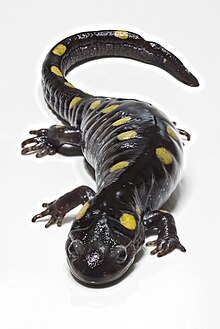Mole salamander
| Mole salamanders | |
|---|---|
 |
|
| Spotted salamander (Ambystoma maculatum) | |
| Scientific classification | |
| Kingdom: | Animalia |
| Phylum: | Chordata |
| Class: | Amphibia |
| Order: | Urodela |
| Family: |
Ambystomatidae Gray, 1850 |
| Genus: |
Ambystoma Tschudi, 1838 |
The mole salamanders (genus Ambystoma) are a group of advanced salamanders endemic to North America, the only genus in the family Ambystomatidae. The group has become famous due to the presence of the axolotl (A. mexicanum), widely used in research, and the tiger salamander (A. tigrinum, A. mavortium) which is the official amphibian of many states, and often sold as a pet.
Terrestrial mole salamanders are identified by having wide, protruding eyes, prominent costal grooves, and thick arms. Most have vivid patterning on dark backgrounds, with marks ranging from deep blue spots to large yellow bars depending on the species. Terrestrial adults spend most of their lives underground in burrows, either of their own making or abandoned by other animals. Some northern species may hibernate in these burrows throughout the winter. They live alone and feed on any available invertebrate. Adults spend little time in the water, only returning to the ponds of their birth to breed.
All mole salamanders are oviparous and lay large eggs in clumps in the water. Their fully aquatic larvae are branchiate, with three pairs of external gills behind their heads and above their gill slits. Larvae have large caudal fins, which extend from the back of their heads to their tails and to their cloacae. Larvae grow limbs soon after hatching, with four toes on the fore arms, and five toes on the hind legs. Their eyes are wide-set and lack true eyelids.
The larvae of some species (especially those in the south, and tiger salamanders) can reach their adult size before undergoing metamorphosis. During metamorphosis, the gills of the larvae disappear, as do the fins. Their tails, skin, and limbs become thicker, and the eyes develop lids. Their lungs become fully developed, allowing for a fully terrestrial existence.
...
Wikipedia
